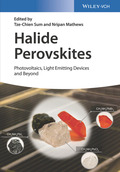Halide Perovskites
Photovoltaics, Light Emitting Devices, and Beyond

1. Auflage Januar 2019
XII, 300 Seiten, Hardcover
130 Abbildungen (30 Farbabbildungen)
Monographie
Kurzbeschreibung
The fundamentals of perovskite materials and device architectures are covered by leading experts in the field to provide real insight into the causes of the superb photovoltaic performance of perovskite solar cells, light-emitting devices and other applications.
Jetzt kaufen
Preis: 149,00 €
Preis inkl. MwSt, zzgl. Versand
Euro-Preise für Wiley-VCH- und Ernst & Sohn-Titel sind nur für Deutschland gültig. In EU-Ländern gilt die lokale Mehrwertsteuer. Portokosten werden berechnet.
- Gedruckte Ausgabe vergriffen -
Real insight from leading experts in the field into the causes of the unique photovoltaic performance of perovskite solar cells, describing the fundamentals of perovskite materials and device architectures.
The authors cover materials research and development, device fabrication and engineering methodologies, as well as current knowledge extending beyond perovskite photovoltaics, such as the novel spin physics and multiferroic properties of this family of materials.
Aimed at a better and clearer understanding of the latest developments in the hybrid perovskite field, this is a must-have for material scientists, chemists, physicists and engineers entering or already working in this booming field.
Electronic Properties of 3D and Low-Dimensional Hybrid Perovskites
Ab-Initio and First Principles Studies
Exciton-Photon Coupling in 2D Perovskites
2D Perovskite Thin Film Transistors
ORGANIC-INORGANIC PEROVSKITE SOLAR CELLS
Fundamentals and Working Principles
Basic Photophysics and Charge Dynamics
Materials development of electron/hole transporting layers
Beyond Methyl Ammonium Lead Iodide Solar Cells
Tandem Perovskite Solar cells
PEROVSKITE LIGHT EMITTING DEVICES
Fundamentals and Working Principles
Towards Electrically Driven Perovskite Lasing
BEYOND PEROVSKITE PHOTOVOLTAICS
Novel Spin Physics in Organic-Inorganic Perovskites
Multiferroic properties of Organic-Inorganic Perovskites
Water-splitting
Nripan Mathews is an Assistant Professor at the School of Materials Engineering in Nanyang Technological University. He pursued his PhD at a joint laboratory of molecular crystals in a collaboration with Commissariat à l'énergie atomique (CEA), Centre national de la recherche scientifique (CNRS) and Université de Pierre et Marie Curie (Paris VI University). He was also a visiting scientist at Prof. Michael Graetzel's laboratory at École Polytechnique Fédérale de Lausanne (EPFL), working on a pan-European project on photoelectrochemical hydrogen production. His research focuses on a wide variety of novel materials (metal oxides, organic semiconductors, graphene, carbon nanotubes, sulfides and selenides) and novel morphologies (one dimensional structures such as nanowires and nanotubes, thin films as well as two dimensional nanosheets) produced through a range of fabrication procedures. He has focused primarily on the electronic and optical properties of these materials and how they can be adapted for practical applications.


